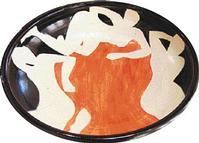By Sana Rose, Contributor 
JEWELLER CAROL Campbell, textile artist/painter Nia Gifford, and ceramist Margaret McGhie, have teamed up
to present Viva La Diva that is now
showing at the Revolution Gallery in
New Kingston.
Campbell, the curator and founder of the gallery, distinguishes herself from other local galleries by promoting crafts since she considers herself a craftsperson. As such, the gallery showcases artwork in materials that were traditionally classified as craft. This exhibition is no different.
A goldsmith, Campbell offers to us bracelets, earrings, cufflinks, pendants, brooches and comparatively a larger number of rings. Her craftsmanship born of a steady hand that creates exquisite finishes is exceptional as usual. Even though the rings outnumber the other items, the necklace/bracelet/earring suites still manage to take centrestage, of which, the design of the 14-karat sterling silver onyx and rubber suite is especially intriguing.
As far as the rings are concerned, the metals are curved, twisted and combined with precious stones to enhance the designs. Usually Campbell's offerings are truly unique where conceptually, she takes ideas, even well-known references such as the Bible and human sexuality and creates fascinating designs that use colour and shape to great effect to guide our eyes towards appealing wholes. But while the current pieces are creative, by Campbell's high standard most are extraordinarily ordinary.
COLOURFUL
Margaret McGhie serves up a colourful display of platters, bowls, goblets and plates that find inspiration for images mainly in the island's flora and to a lesser extent, its fruits and the nude. Complementary colours abound - bright blues are set against delicate pinks, touches of red and splashes of green and yellow. She often makes use of simple, basic forms - cones, cylinders and circles/spheres and in the case of the wall plates, round-edged squares. These forms are those which Post-Impressionist painter Cezanne considered the basic building blocks of a painting and here McGhie finds flashes of inspiration in them, which, although simple and combined with and complimented by painted bold colours and strong linear design.
Her figurative pieces, Reclining Divas and In the Garden Platter find kinship with another French Modernist painter, Henri Matisse who had a penchant for strong colour alongside objects and figures that were narrowed down to their bare essentials - shape, line and, of course, colour which earned him the name along with other artists of similar visual temperament, "le fauve" or wild beast.
The In the Garden Platter also reminisces the painting The Dream. done in 1910 by yet another Frenchman, Henri Rousseau with a figure surrounded by an oddly tranquil and lush jungle and at the same time recall the lush flora/fauna scenes painted by local artist, Amy Laskin. Even with a tinge of Japanese simplicity of form, McGhie links the two dimensions of painting with the three dimensions of ceramics and punches up the colour temperatures by several notches for vibrancy.
SIMPLICITY
Another effort at combined artistic genres is the comparatively larger group of work by Nia Gifford who, like her fellow exhibitors favours simplicity of form. She offers a series of giclee and digital prints on cloth, canvas and paper. The images of landscapes and seascapes are first photographed, then transferred to her sketchbook, manipulated on a computer and then printed. Her work is part photography, painting and textiles.
The pictures never completely deviate from their original images as their semi-abstract form always clues us in on the subjects. They are born of a subtractive method of image-making where aspects of the original images are taken out until they are reduced to simple nuances of shape, space and colour. And although most of the works are framed like paintings, Gifford doesn't only desire that we look at her pieces but also wear them, as a few wraps have been included in the show. From afar, some of the pieces appear as though the patterns have been woven into the cloth and it is only upon close inspection that we realise that they have been printed onto the fabric.
Gifford's somber palette of earth browns, deep reds, purples and blues maintain the essence of each scene, some of which are much closer to their photographic origins than others due to the limited changes made to the images. The more abstract the image, the more the recall the surface explorations of the 1950s Abstract Expressionists. Her print techniques can produce multiple pictures of the same images as in reproductions that the giclee process favours and, while she may repeat an image, we are offered only one original per image as the end products vastly differ from each other.
Viva La Diva is the celebration of the work of three women artists who utilise some kind of technology in the form of tools to manipulate form, shape and space to yield exciting results. The artists complement each other to bring a different spin on the usual - a landscape or seascape, a platter or bowl, a ring or necklace to create tasteful blends of simplicity and imaginative engineering.
The show ends on June 19.

